The Magic of Snow (and Emerging Stories)

This piece hit about this time two years ago. Bringing it back today as the days grow longer and the snow days (hopefully) shorter.
Ezra Jack Keats clipped a strip of four images from Life magazine in 1940. One child. Four endearing expressions and poses.
As the next two decades passed, the little boy in the images remained the same age, with the pursed lips and ballooned cheeks so often worn by children no more than three years old. Bundled up in a long puffy jacket and pants, he lived on Keats’ wall as the artist illustrated one children’s book after another.
In 1962 the child left his static black and white life behind when he woke within the vibrant, adventure-filled pages of The Snowy Day, wondering where the snowball he’d tucked into his pocket the night before had disappeared. The sweetness, innocence, confidence and strength captured within the old images came alive within the book. He’d been given a name, too: Peter.
In 1963 The Snowy Day was awarded the Caldecott Medal.
Finding the Story
There’s a practice in the reality TV world known as “frankenbiting.” Defined by one reality TV editor, frankenbites occur when “you put together one sentence from one answer, another couple words from another answer, another sentence from another day, and make it look like one interview.”
Like reality TV editors, documentary film makers face real people and events. The difference—aside from topic—is found in the editing. Rather than forcing a story—frakenbiting—they help a story emerge. Often, the filmmakers start with one story in mind, only to emerge with another in the end.
In her book Documentary Storytelling, Emmy and Peabody Award-winning filmmaker Sheila Curran Bernard shared:
“In publicity material for the film Sound and Fury, director Josh Aronson says that he initially intended to film five deaf individuals whose experience covered a range of viewpoints on deafness. But in his research, he discovered the Artinians, a family in which two brothers—one hearing, one not—each had a deaf child. This created an opportunity to explore conflict within an extended family over how to raise deaf children. In another example, filmmaker Andrew Jarecki was making a film about birthday party clowns when he discovered, through one of his characters, the story that he eventually told in his documentary, Capturing the Friedmans—that of a family caught up in a devastating child abuse case.”
When Another Story Emerges
According to the Ezra Jack Keats Foundation, Keats didn’t seek children’s books. They found him.
Unable to attend art school despite having received three scholarships, Ezra worked to help support his family and took art classes when he could. Among the jobs he held were mural painter with the Works Progress Administration (WPA) and comic book illustrator, most notably at Fawcett Publications, illustrating backgrounds for the Captain Marvel comic strip.
Ezra went into the Army in 1943, and spent the remainder of World War II designing camouflage patterns. After the war, in 1947, he legally changed his name to Ezra Jack Keats, in reaction to the anti-Semitism of the time. It was his own experience of discrimination that deepened his sympathy and understanding for those who suffered similar hardships.
Ezra was determined to study painting in Europe, and in 1949 he spent one very productive season in Paris. . . . After returning to New York, he focused on earning a living as a commercial artist. His illustrations began to appear in publications such as Reader’s Digest, the New York Times Book Review, Collier’s and Playboy, and on the jackets of popular books. . . .
One of his cover illustrations for a novel was on display in a Fifth Avenue bookstore, where it was spotted by the editorial director of Crowell Publishing, Elizabeth Riley. She asked him to work on children’s books for her company, and published his first picture book in 1954. . . . In an unpublished autobiography, Ezra marveled: “I didn’t even ask to get into children’s books.”
Making Sense of the Story
Like the documentarians, Keats pulled together two points from the raw footage of his life—when one story seemed dominate and then another emerged. One, a clipping of a child, and the other, a request for children’s artwork. On their own, not extraordinary—but together . . . From those two points, came a Caldecott Medal award-winning writer and illustrator, whose stories have delighted children—and their teachers and families—for over half a century.
In his Caldecott Medal acceptance speech, Keats said:
Friends would enthusiastically discuss the things they did as children in the snow, others would suggest nuances of plot, or a change of a word. All of us wanted so much to see little Peter march through these pages, experiencing, in the purity and innocence of childhood, the joys of a first snow.
I can honestly say that Peter came into being because we wanted him; and I hope that, as the Scriptures say, “a little child shall lead them,” and that he will show in his own way the wisdom of a pure heart.
Whatever that impulse was to clip the strip from the magazine . . . He didn’t know it was Peter—or even who Peter was—but . . . When he reached that next dot, asked to not just illustrate—but also write—a book . . . That old clipping re-emerged, perhaps like muscle memory of being able to ride a bike after years without a foot on a pedal. Once you feel the balance, you can find it again within a few wobbles. When he started his own book, whatever led him to clip that strip, led him back to it—and thus to the inspiration for Peter in many books to come.
Reexamining the Story
Earlier this week I volunteered in my daughter’s kindergarten class. The Snowy Day met me as I walked in the room. As a child I couldn’t verbalize why I loved it so much. Something about the snow, of knowing what it was to try to keep a snowball overnight in a jacket pocket, of warm baths and a hug from my mother after hours playing in the freezing cold. I didn’t know that adults considered the book groundbreaking, one that some say is the first children’s book to include an African-American child as a hero. I was just happy to sit on the couch with Mom, turning the pages as she read. It wasn’t until years later that time was spent learning of the author.
Just as amazing as the story of Peter’s inspiration is the story of the artwork itself. Also from Keats’ Caldecott acceptance speech:
I had no idea as to how the book would be illustrated, except that I wanted to add a few bits of patterned paper to supplement the painting.
As work progressed, one swatch of material suggested another, and before I realized it, each page was being handled in a style I had never worked in before. A rather strange sequence of events came into play. I worked—and waited. Then quite unexpectedly I would come across just the appropriate material for the page I was working on.
For instance, one day I visited my art supply shop looking for a sheet of off-white paper to use for the bed linen for the opening pages. Before I could make my request, the clerk said, “We just received some wonderful Belgian canvas. I think you’ll like to see it.” I hadn’t painted on canvas for years, but there he was displaying a huge roll of canvas. It had just the right color and texture for the linen. I bought a narrow strip, leaving a puzzled wondering what strange shape of picture I planned to paint.
The creative efforts of people from many lands contributed to the materials in the book. Some of the papers used for the collage came from Japan, some from Italy, some from Sweden, many from our own country.
The mother’s dress is made of the kind of oilcloth used for lining cupboards. I made a big sheet of snow-texture by rolling white paint over wet inks on paper and achieved the effect of snow flakes by cutting patterns out of gum erasers, dipping them into paint, and then stamping them onto the pages. The gray background for the pages where Peter goes to sleep was made by spattering India ink with a toothbrush.
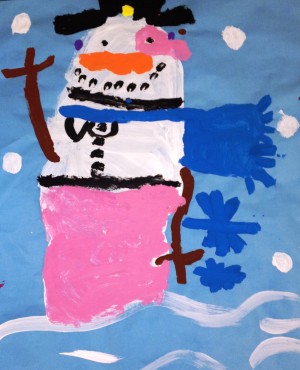
There’s magic in the snow.
Letting the Story Roll
Maya Angelou said, “There is no greater agony than bearing an untold story inside you.” The one thing greater is clinging to the wrong story—whether in your book or in your life. I’m glad Keats let his art roll to where it emerged instead of forcing it where he thought he wanted to be.
As I watched the five and six year olds in my daughter’s class paint their own snowmen, I gave up on keeping the paint off of their clothes and the floor and focused instead on the work itself. Keats was right. There’s a magic in snow, especially when it is paired with a child—and there’s an even greater magic in seeing the creativity that emerges.
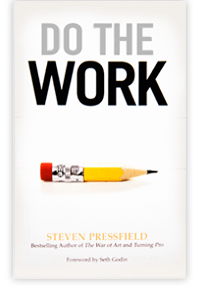
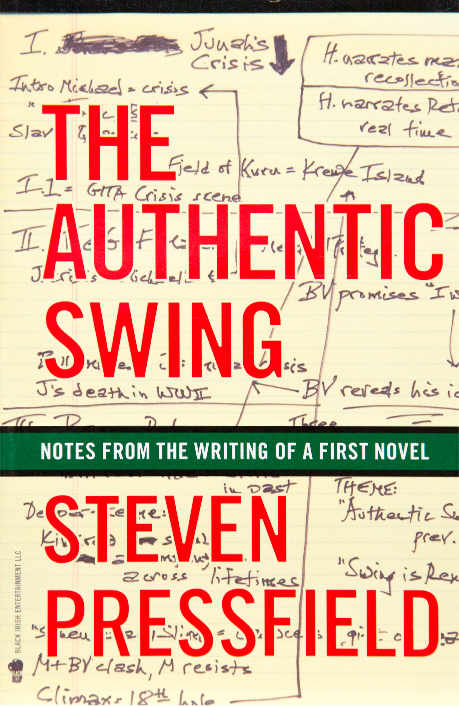
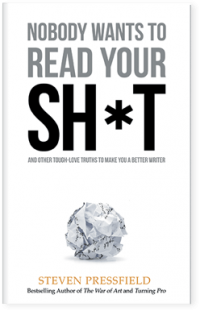
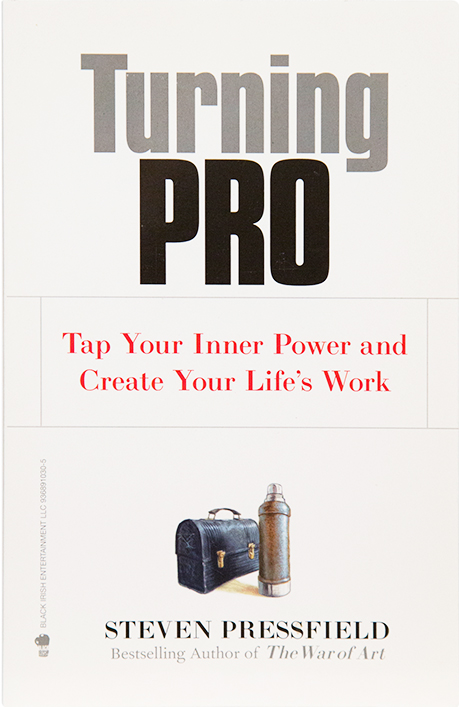
Callie, what a beautiful post! I have my own memories of The Snowy Day but never knew the story behind it. Steve assures us that if we show up the Muse will too and lead us where we are meant to go. Clearly she was holding Keats’ hand and he trusted her enough to follow. This is just what I needed to be reminded of today – as always, thank you.
Thank you for this Monumental post.
Beautiful post.
Meaningful indeed.
Thank you.
I love this post! Snow is magic indeed. For me designing and writing is like building a snowman. I love The Snowy Day and have shared it with my grandchildren recently. After we read it we made them into snowmen! We don’t often get real snow in the Mid-South so we wrapped them in white issue and got an old scarf and hat and presto they were snowmen. Here is a link to the post I wrote about that. http://www.classiclegacy.com/2014/custom-gifts/designing-snowmen-having-fun-and-creating/
“The Snowy Day” is one of my son’s favorite bedtime books. We read it all the time. I had no idea it had been around so long, and was fascinated by the backstory, so thank you for the post!!
One other line in this post stood out: “There is no greater agony than bearing an untold story inside you.”
That would explain a lot of my agony over the last decade or so. I need to mount a better fight against the big “R” I guess…
The Muse is like one of the goddesses of India, everywhere all at once.
I quit my job to write a screenplay based on one of shakespeares works.
Then my street decided to go wild west. I’ve seen people fire guns mere feet away from me. Fourteen year old firing at Grandmothers. Cops who wont get out of the of the car and keep on driving because they’re too scared. The kid across the street was killed by his best friend. Before he died, he said that all he wanted in life was a cross on a chain and a gun.
It still too close. I hate cop shows now.
Thank you for this post. My mother, an enthusiastic and amazing advocate for children loved children’s literature. She and her best friend had the opportunity to meet and Ezra Jack Keats following a children’s literature conference. Their friendship extended for years. She introduced me and my girls to the wondrous stories, the simple but lovely illustrations. To this day The Snowy Day or my all time favorite, Regards to the Man in the Moon are the gifts I share with any new mom.
Reading this brought back floods of memories of hot chocolate with mom in front of the fireplace reading and sharing Ezra’s books with my sister and I.
Callie,
Great post. Just want to say thank you!
I was supposed to write a cookbook. I’m a former chef. Everybody wanted a cookbook. Except the muse. At 3am this morning I could hear my sweetheart stirring. “Buffalo!” I said. “Charlie’s replacing the cattle with buffalo!” “Perfect.” she said. “Don’t change it.” then she rolled over to go back to sleep. I got up and wrote 2,000 words before breakfast. Tears came to my eyes as I read her the draft over coffee. She reminded me: don’t change what you got up at 3 am to write. There’s not a plate of Tapas or a sous vide machine in sight. Wrong book. Charlie’s story had to come out. He won’t let me sleep. The muse provides – the chef abides. It’s below zero and three inches of powdery snow fell this morning. I think I’ll go play. Thanks for the wonderfully poignant post.
What percentage of our day is spent resisting the urgue to do the “practical”, “reasonable” thing, and just go with the creative urges we feel that simply don’t make any rational sense? Great article.
Awesome post, Callie! So many takeaways from it.
For the first time in years, I just spent a weekend in snow. With some of my children and grandchildren. Stories and memories bloom everywhere. The snow doesn’t have to melt for the heart to sprout.
There’s a new biography of Jack London written by Earle Labor. The magic of snow, or the White Silence, as he described it, rescued and transformed his writing. Earle Labor describes how Jack London and another writer suffered through the brutal winter of Alaska and the Klondike. The other writer complained, “Life is pale and cold as the snow…we’ll never read any great stories about Alaska and the Klondike.” The snow broke this writer. But for London, the snow meant “strange thoughts arise unsummoned and the mystery of all things strives for utterance.” It was in this snow that London “unlearned and relearned” how to tell his stories.
Awesome column, Callie. Hard to believe this book wasn’t a part of my life. I will gift it to my son and his bride; snow hasn’t been a part of their lives until this year. And it will be handy when the children come:)
I believe there are no coincidences in life…Each occurrence is are divine; it’s up to us to listen and hear.
Callie,
I must have missed this post in 2014. Snow is an intermittent winter experience in the Pacific Northwest, so it is always a game-changer when we get it.
I’ve often thought of how magical snow is to all creatures. Our dogs and cats have the same ‘let me play’ reaction to snow as children. It totally cracks me up.
The other thought is how loud life is, and snow just seems to quiet everything, including my own mind.
Thanks for the post.
bsn
Thank you Callie.
This is one of my favourite books. I never knew why. My 6-year-old adores it now too — the same copy I had as a child.
I bought paints at Christmas for my son and I. I think about them daily but do nothing. They are itching to tell a story, suffering as Maya Angelou describes.
Letting the story roll– simple idea, not so easy to achieve. I often feel like the stories rush at me and then clog the funnel that let’s the stories drip from my mind and heart on to the page.
Sometimes the right story is in there but the dripping of the wrong story gets in the way.
Thank you for reminding me the power of questioning, why am I writing this.
Azul